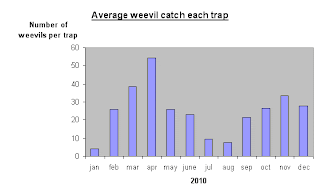A few dedicated weevil trappers in Alhaurin el Grande and Cartama have been collecting data for over a year. Here are the results for our catches in 2010. It is interesting to note that during the hotter months of July and August and the colder month of January the number of weevils trapped was lower than the milder months in Spring and Autumn. December was particularly mild which could explain the high numbers caught so late in the year.
These figures are a good indication of the number of weevils in flight and in search of new palms to infest throughout the year and it will be interesting to see this years results for a comparison. In my own personal trap the figures are already higher than last year(we trapped 90 in January), and as we observe so many deceased palms, everything suggests that this pest is approaching epidemic proportions!Working towards control of the Red Palm Weevil (Rhynchophorus ferrugineus) and maintaining healthy Canary Palms (Phoenix canariensis) in the Mediterranean. Integrated methods like trapping, palm care, timely pruning, ecological treatments (biological control) can help reduce populations in the future.
Tuesday, 29 March 2011
Saturday, 26 March 2011
Red Palm Weevil larvae eat the entire trunk of old Canary Palm!
An article last week shows just how cryptic these insects are! The palm looked well and healthy but the inside of the trunk was totally hollow. Read about it on this great gardening site: Gardening in Spain.
Wednesday, 23 March 2011
Trapping Red Palm Weevil (Rhynchophorus ferrugineus) can help reduce and monitor populations
 | |
| These traps are most effective burried in the ground, soil level with holes in the side. |
Labels:
Canary Palm,
garden,
gardening,
integrated pest management,
pest,
Phoenix caneriensis,
red palm weevil,
Rhynchophorus ferrugineus,
trapping weevils,
Traps
Tuesday, 22 March 2011
If You Don't Care Cut It Down Now !
It is alarming that some people still think that the red palm weevil can be dealt with by pouring washing up liquid over the crown. I suppose that this method was discovered by putting some liquid in a jar and adding a palm weevil Not surprisingly it drowned in the viscose liquid. The same would have occurred using a jar of water. In fact others treated their trees by putting a hose up into the crown and turning on the tap for several hours. Of course they may have been lucky and caught an adult weevil off guard and drowned it but it would not and could not affect the larvae inside the palm, which are the creatures that cause the damage. Another myth that is still prevalent is that the weevils will not attack baby palms or that once a palm is infected it is to late to do anything about it.
The truth is that there are currently only three methods that could eradicate this plague from gardens and countryside. They are the use of insecticides applied either as trunk injections or crown drench. The ecological method of crown drench with microscopic parasites called nematodes. This is the preferred method in the writers view. Thirdly, the sad fact is that the weevils have no natural predators, therefore the use of traps is the only way to prevent the weevils from laying their eggs in a palm in the first place. These traps are not expensive and use two attractants to the weevil called kairomones and pheromones. These are placed in the container and in conjunction with either a poison tablet or 20mm of water will quickly see the demise of all who enter.
A palm can survive after infestation if spotted and treated in time. Regardless of this an infested palm should be treated whether or not it has any chance of survival. The reason being that each female weevil is capable of laying three hundred eggs and if the three hundred eggs develop into 300 adults of which, lets say 150 will be female. In three generations and each generation occurs every 4 months more than a million new weevils will have entered the environment.
Labels:
Canary Palm,
garden,
gardening,
integrated pest management,
larvae,
pest,
Phoenix caneriensis,
population control of red palm weevil,
red palm weevil,
Rhynchophorus ferrugineus,
Traps
Subscribe to:
Posts (Atom)

